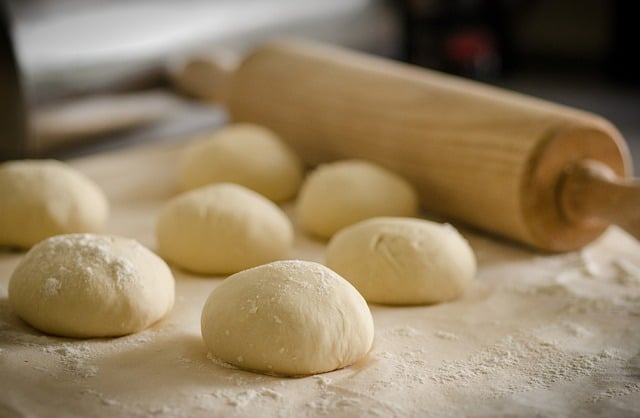Judging from afar, the pizza dough looks so basic and simple and it feels like it really doesn’t need more than bread flour and warm water. Make no mistake however, there is one important ingredient in making pizza dough, the yeast, which is as important to the pizza dough as flour is to a bread dough.
In fact, there are many different types of yeast employed in making pizza crust and all of them work in the same manner to affect the dough in the manner they’re supposed to.
The original pizza recipe, in fact, clearly identifies “yeast” as a major component of making pizza dough, and so it’s fair to say that any recipe that doesn’t include yeast in it is simply not making pizza!
There are quite a few problems that a pizza crust will suffer from if it doesn’t have yeast in it, we’ll discuss more on that as we go on.

Why is yeast important in pizza dough?
Yeast serves two important roles in a pizza dough which makes it an important element in its preparation.
The two important roles that yeast serve in a pizza dough include:
- Creation of carbon dioxide gas from invert sugar which in turn aerates the dough to give the final baked product volume and texture.
- Add flavor to the final baked good.
As you can see, without yeast in a pizza dough, there would be lack of aeration which will result in a dense and flat “bread”, and the yeasty flavor commonly associated with yeast baked products would also be missing too.
What type of yeast is in pizza dough?
With regards to the types of yeast that are used for making pizza dough, there is a variety.
Some of them include:
Instant yeast: Which is a type of yeast that is designed to cut down on the rise time of dough. Instant yeast typically does not require proofing — which is the technique of soaking yeast in a sugary solution (in warm water) in order to activate or bring it back to life. Instant yeast is alive as it comes, and is ready to be mixed into dry ingredients such as flour and salt. One form of instant yeast that is gaining popularity is the pizza crust yeast which is more aggressive than the normal instant yeast and doesn’t require any rise time at all. This means that any dough prepared with it can be knead, rolled slid straight into the oven without the need to proof.
Active dry yeast: This type of yeast is alive yet encapsulate in a casing with medium that allows it to thrive and survive for a long time before it eventually perishes. Because the casing make it unable to be active, the active dry yeast needs to be proofed: meaning that it must be soaked in a solution of warm water between the temperatures of 100°F to 110°F and sugar before it can break out of its casing and become useful in a recipe. Typically, an active dry yeast that is well and alive would turn the sugary water solution into a foamy mixture that would rise to some extent. The active dry yeast does require rise time to leaven dough.
What happens if you don’t add yeast to pizza dough?
It’s very simple, when you decide to ditch the yeast in a pizza dough, then you wont have a well risen dough. The pizza crust wont bake with an airy texture but rather a dense and flat one. It would also not so great on its own, except the topping would be there to cover up for the lack of flavor to some extent.
If you do also decide to ditch the yeast in a pizza dough, know that the “Associazione Verace Pizza Napoletana” would be really mad at you for disrespecting the pizza recipe, and you might also suffer a lot in the final colors of the crust.
Do Italians use yeast in their pizza dough?
Absolutely! Italians pizzerias do employ yeast in their pizza dough which is why their crusts bears a characteristic softness and has the flavors of a properly baked bread.
Italians mostly use compressed yeast and active dry yeast which all require resting and rising, and they employ the principle of inverse proportionality when measuring yeast which means that the more the quantity of water and flour used, the lesser the the amount of yeast added.
Does thin crust pizza have yeast?
Thin crust pizza dough start out with the same basic ingredient as any other pizza recipe out there: water, flour, salt, yeast and sugar. The difference maker in whether the dough will turn out thick or thin is in the way the dough is rolled out prior to topping. A dough that is rolled out quite thin would produce a crust that is thin (although whether crunchy or not would depend on whether you treat the crust with oil prior to putting it in the oven and also whether you preheat the pizza stone first), whereas a dough that is left somewhat thick during rolling would become chewy and a bit dense.
Does pizza flour have yeast in it?
Pizza flour (or bread flour) does not contain yeast in it because yeast is a living organism and so adding it to flour and then storing it that way in the manner that flour is typically stored which in the pantry shelf, would mean that some of the yeast would eventually die, and you’ll have use a fresher yeast to achieving leaving during baking.
The other problem then, is that the yeast that remains alive in the flour wont be measureable, thus increasing the likelihood of employing too much or too little yeast in you baked products.
Products like self raising flour that employ leavening agents like baking powder are able to do so because the leavener isn’t alive and can be stored with the flour without any issue.
Does Dominos Pizza and Pizza Hut dough have yeast in it?
Yes dominos pizza as well as Pizza Hut dough all have yeast in them which is why they bear the characteristics they have: chewy, crunch flavorful and thin.

